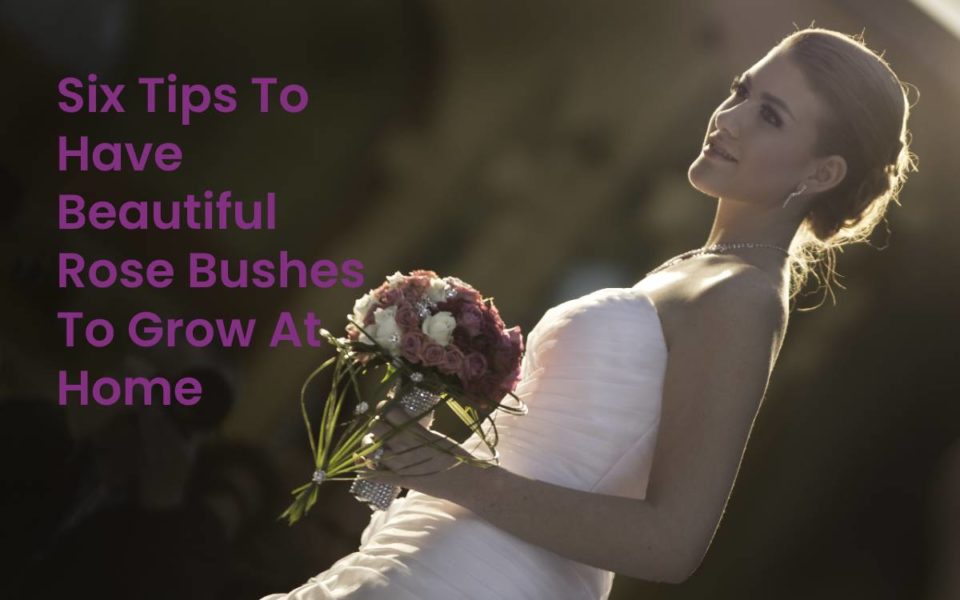Having beautiful Rose Bushes in the garden is easy. It’s something you can get as long as you following advice based on experience. Rose bushes are shrubs that have always attract for various reasons.
Table of Contents.
There is another facet of the rose bushes that were also attracting and still fascinates; they are perennial shrubs, which bloom for years.You may go through the field and see a wild rose, see how these are in the garden, even though nobody cares for them, they continue to flourish beautifully.
1. Choose the variety of your rose bush
 Many people buy rose plants without having an exact idea of the needs of that plant. Decide which rose bush is the best for our garden, depending on the garden itself or the location that We want to give: climbing roses, shrubs, backyard roses, miniature roses, ground covers.
Many people buy rose plants without having an exact idea of the needs of that plant. Decide which rose bush is the best for our garden, depending on the garden itself or the location that We want to give: climbing roses, shrubs, backyard roses, miniature roses, ground covers.
The first decision we have to make Where am I going to put my rose bush? If you want to cover a wall, it must be a climbing rose and not a shrub.
If my garden is small, the best thing is a patio rose bush, which has a smaller size.
Then we would go into secondary details, such as the color of the roses if it is more or less resistant to diseases, how much can it grow, does it bloom a lot?
2. Choose the location well
Not all corners of our garden are suitable for placing a rose bush. It is very common to see rose bushes that are in the middle of a grassy meadow. The grass usually suffocates the rose bushes, preventing them from growing correctly. In these cases, the idea is to leave a good perimeter around the bush, so that the grassroots do not influence its growth.
. The ideal place to plant a rose bush should be:
- A place with direct sun, or where it receives at least 6 hours a day of sun.
- In places with extremely hot climates, they should have some shade during the day. In very cold places, they should plant near a wall that protects them from the cold, but does not take away from the sun.
- Good drainage is compulsory for the soil, and it also has to be fertile. If necessary, we should improve the terrain, adding sand or compost.
- We should not plant rose bushes under trees or shrubs, with which it will compete for sun and nutrients.
- The climbing roses need support, which must hold. They place against the walls, but not all climbing roses are well against a wall.
The reason is that air circulation is poor, and they can attack by fungi, which love hot and humid areas, as it happens near the walls.
3.The land and the fertilizer

To plant rose bushes, we need to dig a hole deep enough in the garden.
The hole must perfectly contain the roots of the rose bush. The measurement is easy to obtain if we are going to plant a rose bush with a pot or root-ball. However, we should not fool with the bare root rose bushes, the hole must also have a good diameter.
Usually, incorporate a good compost at the bottom of the hole when it is a pot rose bush, and I cover all the roots with well-ripen manure when it is a bare root.
The graft point is well to protect for winter. You must make a mound around the rose bush so that it is perfectly protecting.
If the rose is bare-root, I recommend putting it in a bucket of water the night before planting, so that the bush hydrates well, In potted rose bushes, it is advisable to loosen the soil of the root ball a little to facilitate the growth of new roots. This variety of shrubs is usually available from October to March and should plant between fall and spring.
Buying Rose Bushes Online
If we decide to buy rose bushes online, it is most likely that they will serve us by bare roots. They will only be available during certain dates of the year, those that coincide that are suitable to plant.
The best time is always autumn or spring. When we sow in autumn, the soil is still hot and favors the appearance of new roots. But later you have to follow a fertilizer program, so that the rose bush grows healthy and strong, in addition to offering us a good flowering.
The best fertilizers for late winter and early spring are organic matter: compost, manure, guano, earthworm humus, help the rose bush find the necessary nitrogen to create new shoots, after pruning.
When we are in full bloom season, the ideal to have roses without stopping is to use a fertilizer rich in potassium and low in nitrogen.
These “chemical” fertilizers improve flowering and prevent the appearance of annoying pests, such as aphids.
4. Irrigation Rose Bushes

In the first year of the rose bush in the garden, we have to pay special attention to watering.
The roots of the rose bushes are very deep when they are adult shrubs—this vertical growth explains by the need to find water for its survival.
So we can see an abandoned rose bush that continues to flourish, even though nobody cares for it. For sure, your root system is huge.
During its early years, the roots are not fully developing, and we must prevent the surrounding soil from drying out completely.
The best thing is to water abundantly two or three times a week. However, it would also be perfect to have automatic watering.
5. Pruning
For rose bushes to grow healthy, they must prune every year. Pruning prevents the attack of fungi, and stimulates the plant to produce new branches and, in turn, offer us a good flowering.
It is not mean that we have to cut all roses and leave a stump.
Each variety of rose bush needs a different pruning. For example, pruning on climbing roses. It aims to keep the bush in order, and we need air and light to reach the center of the plant, to avoid the appearance of pests.
As a rule, for bush-type roses, their branches should be cut two-thirds their length.
You have to remove the dead branches, t
he damaged ones, the weak ones, and orient the cuts towards the outside, always above a new bud.
6. Pests and diseases
 Enjoying roses in the garden is priceless, but it does require much effort.
Enjoying roses in the garden is priceless, but it does require much effort.
The rose bushes are constantly at risk. They can attack by insect pests, and the most persistent and annoying is the aphid. However, it can also be a victim of fungi, especially in spring.
The fungal attack can if we choose the variety well, we place the rose bush in the correct place in the garden, we fertilize well.
All in all, fungi may occur, especially in hot, rainy springs. In that case, we must remove the parts which affect the rose bush and quickly remove them from the garden, and then apply a suitable fungicide.
For insect pests, you would have to know which pest is affected, because the aphid is not the same as the red spider or the rose slug.
Aphids on a Red Rose Bushes
Plant a rose bare bush root, in a pot or root-ball In the market and online, we can find three forms of presentation for a rose bush: pot, bare-root, and root ball.
The advantage of bare root roses is, above all, the price, and they are cheaper than others.
These are the differences between each other:
- Potted. They are grown in a pot. They have a good year, with the only precaution to choose dates when there are no frosts.
- A bare root is usually available from November to February. They are cultivating in fields where they are collects and maintains in a process similar to hibernation.
The ideal is to show them during the autumn on frost-free days, and failing that, in spring, never in summer.
Choosing the Right Rose Bushes for Potting
 Have to choose the right roses for pots. Although many rose bushes admit to being plant in pots, the ideal is to choose low bushes, such as patio roses or Pitiminí roses.
Have to choose the right roses for pots. Although many rose bushes admit to being plant in pots, the ideal is to choose low bushes, such as patio roses or Pitiminí roses.
These rose bushes have a root system according to their height, optimal for being in a pot.
The other roses, although they may be in a pot, the growth will be much less than if it were in the garden,
Choosing the Right Pot to Plant Rose Bushes
A mistake we can make when planting rose bushes in pots is the wrong choice of container.
The material does not have too much importance, although I am in favor of clay pots, for aesthetics. Because in full sun, they are the best pots for roots, It recognizes that if we have to move from time to time, When weighing our rose bush, the weight of the container is an aspect to consider.
The most important thing about a good rose pot is its depth. It should not be less than 35 cm; the roots of the rose bushes tend to grow very deep and do not extend as far to the sides
Compost and Suitable Fertilizer
Once the selection of various roses and the pot, good compost is an indispensable part of success.
We must fill the pot with compost suitable for roses, and also, when we are sowing, add a suitable fertilizer. I choose a guano-based fertilizer, ideal for potted roses.
If we buy a pot rose bush, we will press the roots a little to stimulate their growth.
We press the compost around well so that the plant does not fall, and then we water well to eliminate air bubbles that may have remains in the pot. By following these tips, you will have wonderful rose bushes for many years.


